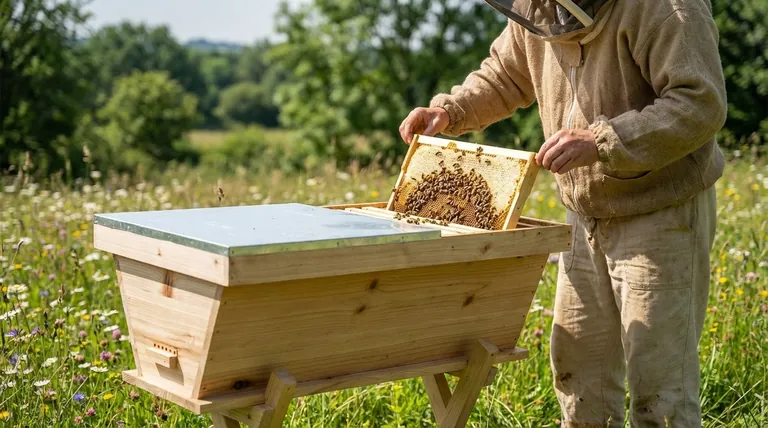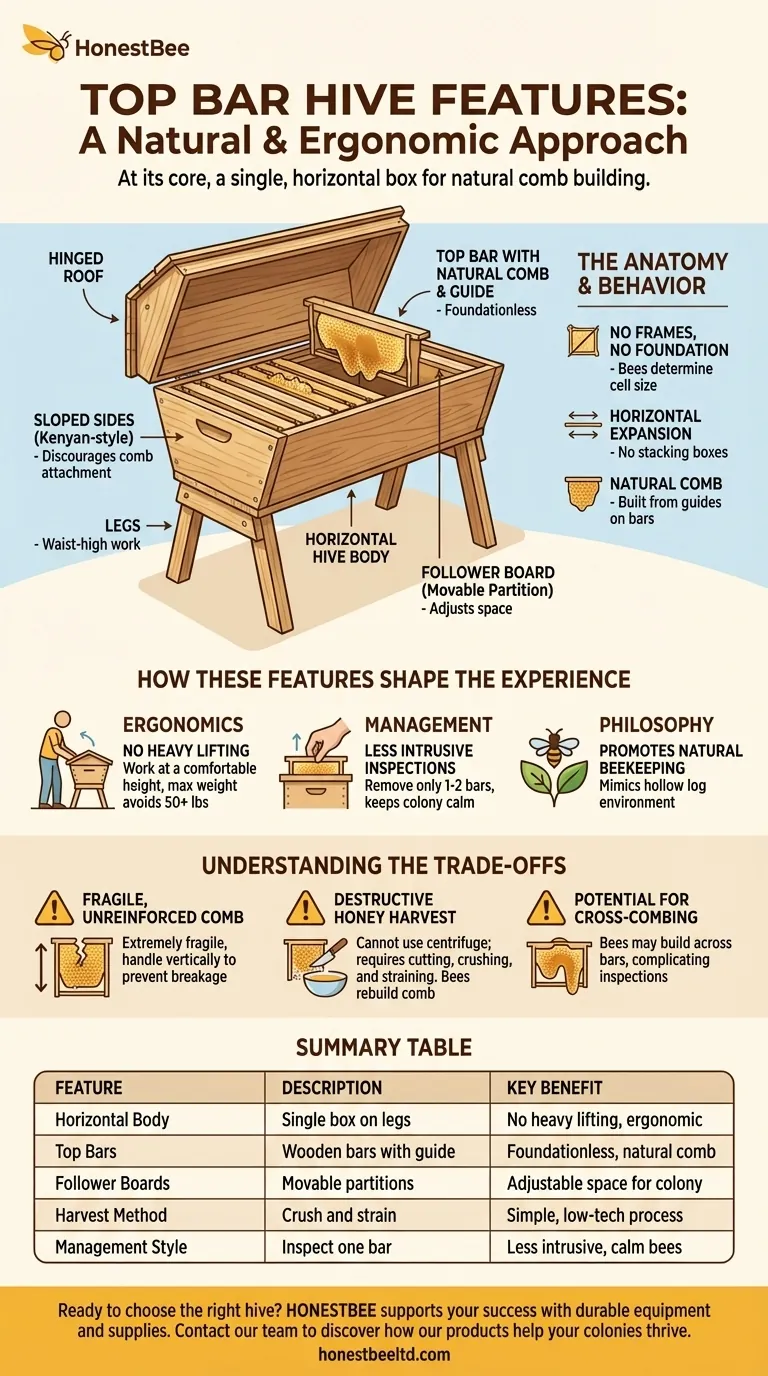At its core, a top bar hive is a single, horizontal box that allows bees to build their comb naturally, hanging from simple wooden bars laid across the top. Unlike the stacked boxes of a more common Langstroth hive, a top bar hive does not expand vertically and requires no heavy lifting, making it a fundamentally different approach to beekeeping.
The defining features of a top bar hive are not just its physical components, but how they create a management system centered on simplicity, accessibility, and a more natural environment for the bees.

The Anatomy of a Top bar Hive
A top bar hive's design is intentionally simple, consisting of a few key components that work together to create a self-contained colony environment.
The Hive Body: A Horizontal Home
The main structure is a long, horizontal trough, typically made of wood and set on legs. This raises the entire hive to a comfortable working height, usually around waist level.
The sides of the hive body are often sloped inwards, forming a trapezoidal shape. This is known as a Kenyan-style top bar hive. The slope discourages bees from attaching their comb to the hive walls, making inspections easier.
The Top Bars: The Core of the System
Instead of complex, four-sided frames, this hive uses simple wooden bars that rest across the top of the hive body. Each bar typically has a guide—such as a beveled edge or a thin strip of wood—running along its underside.
This guide encourages the bees to build their wax comb straight down from the center of each bar. Because there is no pre-made foundation, the bees draw out their own comb in the cell sizes they naturally prefer.
The Roof and Follower Boards
A roof, which can be flat or gabled, protects the colony from rain and sun. A well-designed roof is often hinged, allowing the beekeeper to open it without having to set it on the ground.
Inside the hive, follower boards act as movable walls. These partitions allow you to adjust the size of the interior space to match the colony's population, helping them maintain temperature and build comb more efficiently.
How These Features Shape the Beekeeping Experience
The unique design of the top bar hive directly translates into a distinct management philosophy and workflow.
Ergonomics: No Heavy Lifting Required
Because the hive expands horizontally, you never have to lift heavy boxes filled with honey, which can weigh over 50 pounds (23 kg) in a traditional hive. All work is done at a fixed, comfortable height.
Management: Less Intrusive Inspections
To inspect the colony, you only remove one or two bars at a time. The rest of the bars remain in place, acting as the "roof" for the colony.
This keeps the majority of the colony covered and calm, reducing defensive behavior and minimizing disruption to the bees' environment.
Philosophy: Promoting Natural Beekeeping
The top bar system is favored by beekeepers who prioritize a more natural approach. The bees determine their own comb cell size, and the lack of frames and foundation more closely mimics how they would build in a hollow log.
Understanding the Trade-offs
While appealing, the top bar hive design comes with important trade-offs that every prospective beekeeper must understand.
Fragile, Unreinforced Comb
The comb is only attached to the top bar. It has no side or bottom support, making it extremely fragile.
You must always hold a top bar vertically, like a picture in a frame. Tilting it horizontally can cause the heavy, wax comb to break off and fall, damaging the colony and frustrating the beekeeper.
The Honey Harvest Is Destructive
Honey cannot be extracted using a centrifuge, as this would destroy the frameless comb. Instead, the beekeeper cuts the comb from the top bar.
The honey is then harvested by crushing the comb and straining the honey out of the wax. This means the bees must rebuild the entire comb from scratch after every harvest, which requires significant energy and resources.
Potential for Cross-Combing
Despite design features like sloped sides and guides, bees will occasionally build their comb across multiple bars. This "cross-combing" can make it impossible to remove individual bars without cutting through comb and disrupting the hive.
Making the Right Choice for Your Goal
The decision to use a top bar hive should be based on your personal beekeeping philosophy and physical capabilities.
- If your primary focus is physical accessibility and avoiding heavy lifting: The fixed, waist-height design of a top bar hive is its most significant advantage.
- If your primary focus is natural beekeeping with minimal equipment: The foundationless, frameless system allows bees to build comb as they would in the wild.
- If your primary focus is maximizing honey yield with reusable comb: The destructive harvest method and more fragile comb of a top bar hive are significant drawbacks compared to a Langstroth hive.
Understanding these core design principles empowers you to choose the hive that best aligns with your physical needs and beekeeping goals.
Summary Table:
| Feature | Description | Key Benefit |
|---|---|---|
| Horizontal Body | Single, long box on legs. | No heavy lifting; ergonomic access. |
| Top Bars | Simple wooden bars with a guide. | Foundationless, natural comb building. |
| Follower Boards | Movable interior partitions. | Adjustable hive space for colony size. |
| Harvest Method | Crush and strain of honeycomb. | Simple, low-tech process. |
| Management Style | Inspect one bar at a time. | Less intrusive, calmer bees. |
Ready to choose the right hive for your beekeeping philosophy?
Whether you're a hobbyist drawn to the natural approach of a top bar hive or a commercial operation requiring the efficiency of Langstroth equipment, HONESTBEE has the supplies and expertise to support your success. We supply durable beekeeping equipment and supplies to commercial apiaries and distributors through our wholesale-focused operations.
Contact our team today to discuss your specific needs and discover how our products can help your colonies thrive.
Visual Guide

Related Products
- Top Bar Beehive for Beekeeping Wholesales Kenya Top Bar Hive
- Long Langstroth Style Horizontal Top Bar Hive for Wholesale
- HONESTBEE Professional Multi-Functional Hive Tool with Ergonomic Wood Handle
- HONESTBEE Advanced Ergonomic Stainless Steel Hive Tool for Beekeeping
- HONESTBEE Professional Long Handled Hive Tool with Precision Cutting Blade
People Also Ask
- What are the benefits of extra wax production in top bar hives? A Natural Byproduct for Craft & Efficiency
- How should a beekeeper prepare a top-bar hive for overwintering? A Guide to Ensure Colony Survival
- What are the benefits of a top bar hive? A Natural, Low-Impact Approach to Beekeeping
- Why are hive inspections easier with Top Bar Hives? Achieve a Calmer, Safer Approach to Beekeeping
- What are the advantages of harvesting honey from a top bar hive? Low-Cost, Simple Harvesting for Beekeepers



















